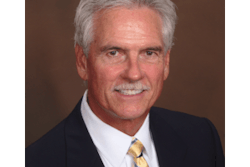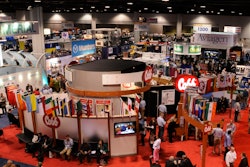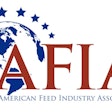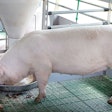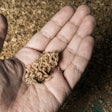The year is 1909.
British explorer Ernest Shackleton finds the magnetic South Pole; the Wright brothers deliver the first airplane to the U.S. Army; the United States Mint issues the first Lincoln penny. Shortly after President Taft is inaugurated during a March snowstorm which dumped 10 inches of snow on the nation’s capital, a group of 18 feed manufacturers gathered in Chicago and agreed to form a new organization called the American Feed Manufacturers Association.
After that first meeting, the AFMA consummated its existence at the group’s first annual convention a few months later on May 25, 1909, and have been meeting annually ever since.
From those humble beginnings in Chicago, the organization now known as the American Feed Industry Association (AFIA), has grown and evolved into a powerhouse advocate for the feed industry and its many partners. That growth, constantly fueled and fired by the vision of those founding fathers, is based on a solid set of core beliefs built around service, education and cooperation.
“Much of what we [AFIA] are about today can be directly attributed to why the organization was created in the first place,” says Joel Newman, president, AFIA. “That mission is to represent the total feed industry in the best way possible to ensure a productive and beneficial environment in which to do business.”
Newman leads a staff of about a dozen professionals who represent the business, legislative, regulatory and international interests of the animal feed industry, as well as the companies that supply the industry along with other key partner groups.
Four membership promises
Several years ago, AFIA moved to restructure itself as a means to be more responsive and better able to meet the needs of a rapidly changing industry. As part of that redesign and new model, AFIA made four promises to its members. These commitments are based on what AFIA members have expressed as most important to their needs and business operations. Each promise contains multiple sub-statements that support the primary covenant. The four guarantees include:
1. AFIA members will have a voice as part of the Total Feed Industry
— Members join with representatives from all industry segments, gathered around the AFIA table, to take part in creating one powerful, united voice.
2. AFIA will provide to its member companies expert legislative and regulatory leadership and representation
— Membership offers participation on decisions made about critical legislative and regulatory issues impacting their businesses.
3. AFIA will make available to its members confidential staff expertise
— Individualized personal support services are available upon request.
4. AFIA provides its members access to unparalleled member services
— Unique opportunities are offered for business leadership, education and networking forums
While these four promises were created as a result of a more recent effort to realign its operating model, the spirit behind these promises has been embodied in decades of active and effective service.
Achievements over the years
理查德•卖家AFIA的副总统for Feed Regulation and Nutrition, has been with AFIA for 17 years and is keenly aware of the organization’s list of achievements during its history.
He notes that after its founding in 1909, the move to coalesce the feed industry began in earnest, so the mission the group carries today — representing the total feed industry — truly has its roots in the early days of AFIA.
“The early mission wasn’t to rewrite rules and regulations but to create an organization that worked in tandem to bring about rules and regulations that benefited the industry and its customers,” Sellers notes. “It was created to bind manufacturers together to level the playing field and prove to the government and the world it could move in a united fashion. I feel strongly that the staff, leadership and legions of industry partners who have served through the years have stayed true to that vision.”
卖家指出AFIA h的其他关键的里程碑ad a role, including the 1938 Food Drug and Cosmetic Act which served as the bedrock legislation for creating a feed ingredient approval process.
In the 1960s, regulatory bodies looking to pass the medicated feed regulations used AFIA’s guidance in helping members better understand the reasoning and execution in moving from voluntary to mandatory product safety information reporting to the FDA. With feed safety, product efficacy and integrity the goals, AFIA worked alongside the FDA to create a best management practices system for medicated feeds. That goal of working proactively and constructively with regulatory agencies continues today.
“Through our Safe Feed/Safe Food Certification program, we’ve been able to demonstrate how our work can become a standard bearer for adoption and implementation of quality assurance certification, without the need for excessive regulatory oversight,” says Sellers. “In fact this program is highly regarded as a template by the FDA and other agencies, in the certification process, and we’re in contact with international parties interested in establishing similar programs.”
As former AFIA president Oakley Ray reinforces, it’s the cooperative spirit that makes reaching these milestones possible.
“The need to organize the many different organizations that touched the industry into a combined force was vital to our survival and relevance,” says Oakley. “Bringing in the Midwest Feed Manufacturers Association, National Feed Ingredients Association and later, the Equipment Manufacturers Association, was a significant move in the right direction.”
What’s on tap for the next century?
Newman and Sellers are both optimistic about the future of the industry and the organization. Obviously, the role of guiding its membership and industry through the rough waters of the regulatory arena remains a top priority, but industry leaders (some are former and current AFIA leaders) agree: It comes down to delivering value to the marketplace.
“The next 100 years should find AFIA membership taking a more active and proactive role in driving and managing change in our industry,” states Don Orr, current AFIA board chairman and president of JBS United, Sheridan, IN. “Our organization is the voice of our industry in Washington, D.C., and our membership needs to be the face of quality assurance to our customers and, more importantly, our customer’s customers.
“Our membership is very diverse today and requires us to be accountable and responsible to all links of the human and animal food chains. I would imagine when people look back on our record 100 years from now, that will be a strong metric by which our legacy will be judged,” Orr concludes.
For former board chairman, Dwight Armstrong, it comes down to the need to inform, educate and bring perspective to various stakeholders.
“The scope of responsibility for the organization has and will continue to change dramatically,” says Armstrong founder of JDA Consulting, and former group vice-president of Provimi Holding. “The constituencies have expanded greatly and not just here in this country, but around the globe. Really, no organization is better positioned to manage the flow of information and outreach to our consumer and regulatory publics, better than AFIA.
“But, it certainly won’t be easy and that’s where key relationships with private industry and the public sector will need to be continuously cultivated,” he cautions.
One thing is for certain, if the AFIA enjoys a century of success at building coalitions, wading through the morass of the regulatory process and creating new, value-driven programs for its members, the next 100 years will find the feed industry in great shape.





